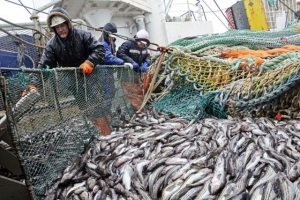
In 2020 season A of the Sea of Okhotsk pollock fishery (NSOO – Northern Sea of Okhotsk, WK – West Kamchatka, KK – Kamchatka-Kuril subzones) 25 scientific observers worked at sea (+3 persons comparing to 2019). 15 observers were from TINRO, 7 – KamchatNIRO, 2 – MagadanNIRO and one observer who performed target at-sea survey on sea birds interaction worked with Kamchatka office of Pacific Institute of Geography of Russian Academy of Science. Totally, scientific observers from three fishery research institutes spent 1480 vessel-days1 (+10% comparing to 2019). Total number of hauls observed and recorded by observers grew substantially (+38%) comparing to the previous season up to 3349 hauls. Monitoring coverage rate by observed hauls exceeded 15% of total operations conducted on the target mid-water trawl pollock fishery in season A 2020.
Number of biological samples of pollock grew slightly. In 2019, TINRO and KamchatNIRO concluded that the number of samples for measuring and bio analysis reached optimal level and further increase was not required. Instead, this year we focused on extension of data series obtained from different types of vessels, gears (modifications of pelagic trawl), and fisheries.
In 2020-A, 30 vessels engaged into target pollock fishery carried observers (part or full time). Totally 125 vessels were engaged in target pollock fishery this year, so fishery’s observer coverage rate by number of vessels almost reached 24% of vessels engaged into monitoring program in 2020 were rotated towards to 2019.
In 2020, for the first time 3 observers were deployed on STRM-size trawlers (average catch-processors, FVS-419 type). One observer was on mothership that received and processed catches from average catchers (STR-type trawlers equipped with pelagic trawl).
KamchatNIRO traditionally deployed observers to monitor and collect information on pollock Danish seiner fishery. Two observers collected information on the mothership and onshore factory that received catches from multiple Danish seiner vessels.
According to TINRO calculations, in 2020-A almost 75% of fishing grounds of the SOO (KK, WK, NSOO) were covered by monitoring and observations where and when 94% of catch were harvested.
All scientific observers conducted specific observations of marine birds and mammal interaction and by-catch during fishery as prescribed in their briefing. Totally, during season scientific observers conducted 1945 stations during haul operations. Besides that, a target at-sea survey on birds interaction (and marine mammals as well) was conducted during fishery by an observer-ornithologist who made specific observation stations on seabird interaction as well registration of birds presence within the traditional fishing areas.
Since 2019 TINRO with support from PCA extended SOO observer program to East Sakhalin pollock fishery. In 2019-A (January, April-May) 5 observers from TINRO conducted monitoring of the fishery and collected bio-statistical information on pollock catches, by-catch species, and interaction with birds and mammals. In previous years, the fishery was monitored by SakhNIRO.
In 2020 PCA continued to support development of observer program for East Sakhalin in order to bring the level of monitoring of this fishery up to the level of the main SOO pollock fishery. For this reason, we increased number of observers and developed a joint deployment strategy for the SOO and East Sakhalin fisheries. The season-A strategy for East Sakhalin fishery provided to cover the most productive periods of target mid-water trawl pollock fishery in January and in April-May (in February and March East Sakhalin is closed with ice). One observer started working on East Sakhalin in December 2019, in January there were 3 observers in January. Later they moved to the northeast part of the SOO, and then after the SOO season ended on April 10th 7 observers moved back to East Sakhalin for April-May.
In 2020-A, 7 scientific observers worked on pollock fishery in East Sakhalin subzone (+2 persons comparing to 2019). 5 observers were from TINRO, 1 – KamchatNIRO, and one observer who performed target at-sea survey on seabird interaction worked for Kamchatka office of Pacific Institute of Geography of Russian Academy of Science. Totally, scientific observers spent 163 vessel-days at sea2 (х 3,5 times, 47 vessel-days in 2019).
Total number of hauls observed and recorded by observers also grew substantially (x 2 times) from 135 in 2019-A up to 271 in 2020-A. Observer coverage rate by observed hauls exceeded 17,0% of total operations conducted on the East Sakhalin target midwater trawl pollock fishery in season A 2020 (7,5% in 2019-A).
Number of biological samples of pollock from measuring and biological analysis grew from 12500 samples in 2019-A up to 33400 samples this year.
In 2020-A, 7 vessels engaged into target pollock fishery carried observers. Totally 36 vessels were engaged in target pollock fishery this year, so fishery’s observer coverage rate by number of vessels almost reached 20% (about 15% in 2019-A). It should be noted that some vessels harvested pollock in ES, but during small number of vessel-days, so they were registered in the statistics of Fishery Monitoring System but did not provide substantial amount of catch or operations. Motherships as well as average trawlers or other gears did not operate in the East Sakhalin subzone in season-A.
According to TINRO calculations, in 2020-A monitoring activities covered all key fishing grounds of East Sakhalin where 92% of catch was harvested.
All scientific observers conducted specific observations of seabirds and marine mammal interaction and by-catch during fishery as prescribed in their briefs. Totally, during season scientific observers conducted 192 stations during haul operations (81stations in 2019-A).
